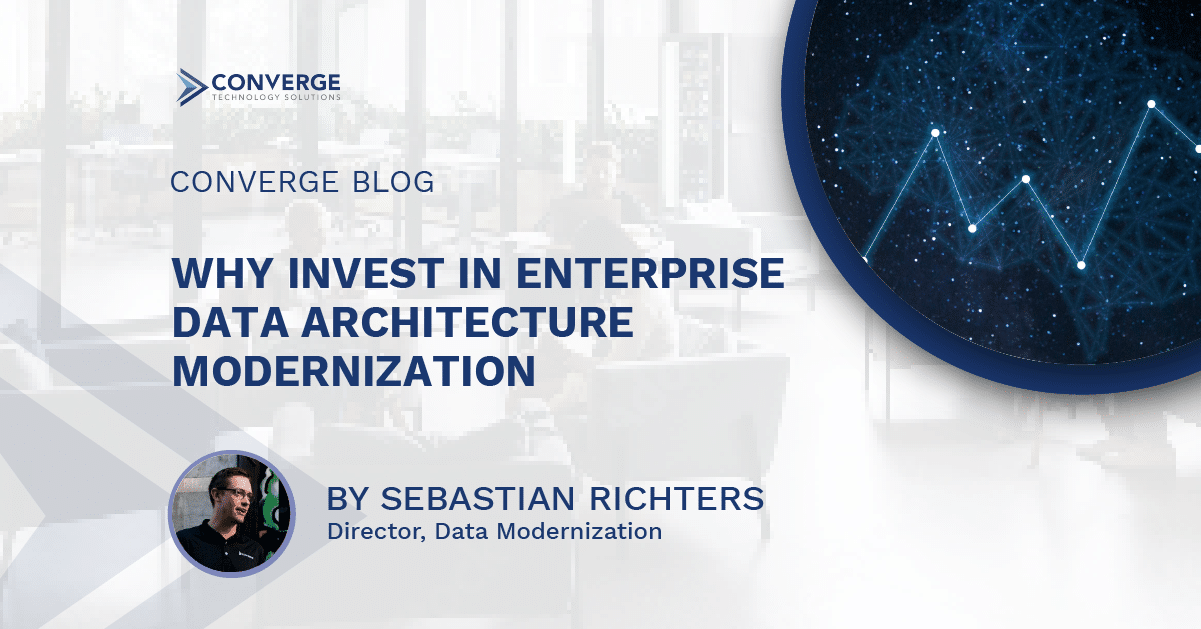Data architecture modernization involves updating an organization’s data management infrastructure, tools, and processes to keep pace with evolving technologies, best practices, and trends. Modernizing data architecture is essential for businesses to overcome challenges posed by legacy systems, eliminate data silos, and efficiently manage, store, and analyze data for better decision-making and innovation.
As data becomes more and more central to businesses, it is becoming clear that outdated data architectures can no longer keep up with the demands of the modern enterprise. Data strategy is a crucial data element of modernization, as it helps businesses identify their data needs and align them with their overall objectives.
Related article: Getting Started with Data Science in Your Organization
To stay competitive, businesses need to modernize their data architectures to be able to better manage, integrate, and analyze their data and data entities. By doing so, you will be able to better manage data and its flow, giving you a significant competitive advantage.
Let’s dive into the importance of modernizing your data architecture in today’s digital world, incorporating essential components like data standards, data modeling, and data science.
The Challenge of Managing Big Data
The way we store, manage, and analyze data has changed dramatically in recent years. Yet, many organizations are still using data architectures that are based on legacy technology and processes. This can lead to several problems, including:
- Inefficient Data Management & Poor Data Quality
- Difficulty Integrating New Data Sources
- Lack of Visibility into Data
- No flexibility to keep up with Business Demands
Data flow and standards are crucial parts of the data architecture design in addressing these challenges. When data isn’t properly managed, it is difficult to use it for business intelligence, analytics, and decision-making. Data integration is another challenge that organizations face when trying to make use of their data.
It can be difficult to integrate data from different sources, including on-premise data, cloud data, and big data. The only way to address these problems in their totality is to undergo data architecture modernization.
Key Components of Modern Enterprise Data Architecture – Data Architecture Framework
A modern enterprise data architecture is essential for organizations seeking to harness the power of data for improved decision-making and insights. The following key components of data architecture form the backbone of a robust data architecture:
Data Lake
A data lake is a centralized repository for storing vast amounts of raw, unstructured, and structured data from various sources. It provides a scalable and flexible storage solution that can accommodate the rapid influx of data and enables users to access and analyze the data. By maintaining data in its native format, they promote agility and allow organizations to capitalize on emerging technologies and analytical techniques.
Data Warehouse
A data warehouse is a structured storage system designed for high-performance querying and reporting. It consolidates data from multiple sources, transforming and organizing it into a cohesive schema for efficient analysis.
Data warehouses employ a dimensional model, which simplifies the complexity of data architectures and enhances query performance. They are optimized for analytical processing and facilitate business intelligence and reporting tasks by providing a single source of truth for enterprise data.
Data Lakehouse
The Data Lakehouse combines the best elements of data lakes and data warehouses to deliver the reliability, strong governance and performance of data warehouses with the openness, flexibility and machine learning support of data lakes.
The Data Lakehouse architecture allows the use of one centralized repository for all use cases you may have and is able to handle big data with ease. With the abstraction of infrastructure making it more approachable to end customers, we have seen an increased demand of Data Lakehouse migrations.
Data Integration
Data Integration involves the process of combining data from disparate sources to create a unified and consistent view. It is crucial for data-driven decision-making and supports data quality and governance efforts. There are two main approaches to data platforming and integration: ETL (Extract, Transform, Load) and ELT (Extract, Load, Transform) are the two dominant integration methods.
ETL focuses on extracting data from source systems, transforming it into a desired format, and then loading it into a target system, such as a data warehouse. ELT, on the other hand, extracts data from sources, loads it into a target system, and then performs transformations within the target environment.
The choice between ETL and ELT depends on factors such as data volume, processing capabilities, and organizational data requirements.
Advanced Analytics and Artificial Intelligence
Advanced analytics and artificial intelligence (AI) enable organizations to derive deep insights from their data and support decision-making through techniques such as machine learning, natural language processing, and predictive analytics. These technologies allow organizations to uncover hidden patterns, predict future trends, and automate decision-making processes.
Integrating advanced analytics and AI into a modern data architecture ensures that organizations can capitalize on their data assets, driving innovation and competitive advantage.
How Modernizing Enterprise Data Architecture Solves Problems
Modernizing enterprise data architecture can solve all the above problems. Enterprise data architecture modernization is a solution that can help organizations overcome most of these problems by providing them with effective data platforms to manage and integrate their existing data. Here’s how they do it:
Eliminate Data Silos
The biggest problem with enterprise data is that it is often siloed, with physical data stored in different places, making it difficult to access and use. Data modernization can help organizations overcome this problem by providing them with a platform to manage and integrate their common data from different sources, including unstructured data.
A new modernized architecture can help organizations connect their data and make it accessible from one central location. This will help to eliminate data silos and make data more accessible and usable.
Enhance Data Quality
One of the benefits of enterprise architecture framework modernization is that it can help organizations improve the quality of their data. By providing a platform to manage and integrate data, modernization can help organizations connect data from different sources and ensure that data is of excellent quality. Quality data supports organizations to improve the accuracy and completeness of their data, reduce inconsistencies, and ensure raw data is transformed into valuable insights.
Improve Data Integration
Data engineers and data scientists often face the challenge of integrating data from multiple sources. Modernization provides a data integration platform that consolidates data, including logical data and data collected from various sources, into a single unified view.
Better Business Intelligence, Analytics, and Decision Making
A well-designed data architecture describes how data systems will support organizations in improving their business intelligence (BI), analytics, and decision-making processes. By consolidating data from multiple sources into a single view, data architecture can help organizations get a more accurate understanding of their business, driven by data. This can help organizations make better decisions, update data efficiently, and improve their performance.
Cost Savings and Efficiency Gains
Modernizing enterprise data architecture not only enhances data accessibility and quality but also leads to cost savings and efficiency gains. By streamlining data management processes and consolidating data storage, organizations can reduce overhead costs associated with maintaining legacy systems and infrastructure.
Moreover, the modernized architecture allows for improved automation and optimization of data processing tasks, which can save both time and resources.
Better Data Security and Compliance
Data security and compliance are critical concerns for organizations in today’s digital age. Modernizing enterprise data architecture framework can significantly improve data protection mechanisms by implementing robust encryption, access controls, and monitoring capabilities.
This helps to safeguard sensitive information and reduce the risk of data breaches and cyber threats. Furthermore, a well-designed data architecture can simplify regulatory compliance by establishing centralized data governance processes, ensuring data integrity, and providing comprehensive audit trails.
The Importance of Data Architecture Diagrams
Understanding and effectively communicating the relationships between various components in a modern enterprise data architecture is crucial for successful implementation and management.
Data architecture diagrams serve as essential tools to visualize these connections, providing a clear, easy-to-understand representation of your organization’s data infrastructure. These diagrams can illustrate how data is managed, and how data usage is aligned with data and business needs.
Conclusion
It’s clear that modernizing your enterprise data architecture is crucial for businesses today. With the ever-changing landscape of technology, it is essential to keep up-to-date to stay competitive. By implementing a modern data architecture, businesses can improve their decision-making process, better utilize their data, and improve their overall efficiency. Building the data architecture to handle complex data needs is essential for any growing business.
For any growing business, investing in data architecture modernization is a must. But to pull it off properly, you’ll need help from the experts at Converge Technology Solutions. We leverage strategy and development expertise to help you make sense of all the data you have. With our help, you can tap into your data and use it to unleash your organization’s full potential. Partner with ConvergeTP Analytics today, and let’s start your modernization journey together.





